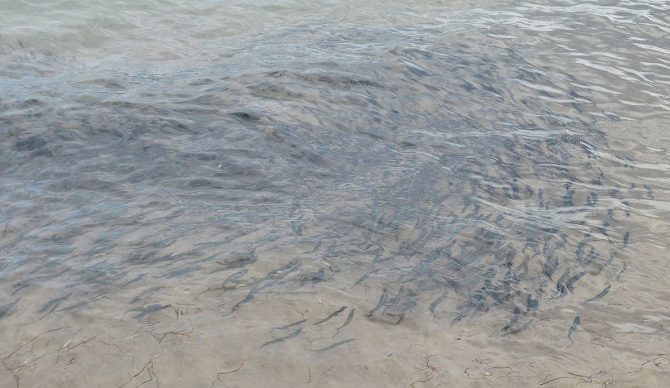
A small school of capelin off the coast of Newfoundland. Photo: Wikimedia Commons
Oceanographers from MIT and Norway recently published a study after observing a staggeringly large predation event. In 2014, in the Barents Sea off the coast of Norway, over 10 million fish were eaten in just a few hours.
The prey fish were capelin, a tiny anchovy-sized Arctic fish that’s often used as a bait fish, as fertilizer, or as a food source in select communities. The predator fish were the Atlantic cod – which are the capelin’s main predator.
Every February, billions of capelin migrate from the Arctic Sea to the coast of Norway, where they lay their eggs. It’s long been known that Atlantic cod feed on the capelin as they migrate south, but until researchers studied the numbers, it wasn’t clear just how many capelin the cod can consume.
“Using a sonic-based wide-area imaging technique, they watched as random capelin began grouping together to form a massive shoal spanning tens of kilometers,” MIT authors wrote. “As the capelin shoal formed a sort of ecological ‘hotspot,’ the team observed individual cod begin to group together in response, forming a huge shoal of their own. The swarming cod overtook the capelin, quickly consuming over 10 million fish, estimated to be more than half of the gathered prey.”
While that might sound like it could be a catastrophic blow to the capelin population, it’s unlikely to have much effect on global numbers.
“In our work we are seeing that natural catastrophic predation events can change the local predator prey balance in a matter of hours,” explained Nicholas Makris, professor of mechanical and ocean engineering at MIT. “That’s not an issue for a healthy population with many spatially distributed population centers or ecological hotspots. But as the number of these hotspots deceases due to climate and anthropogenic stresses, the kind of natural ‘catastrophic’ predation event we witnessed of a keystone species could lead to dramatic consequences for that species as well as the many species dependent on them.”
The capelin is a very important part of the food chain, feeding not just cod but many other predators as well. The predation event was recorded a decade ago during an exploratory trip where a team of scientists used a sonic imaging technique known as the Ocean Acoustic Waveguide Remote Sensing (OAWRS) system. An acoustic array is attached to the bottom of a vessel, where it sends sound waves in all directions. Those waves bounce off anything and everything in their path. Another set of acoustic receivers picks up the reflected sounds, giving the viewer an idea of what’s happening for miles around.
In prior years, scientists weren’t able to tell exactly what kind of fish they were seeing, though. But using something called a multispectral technique, they can now tell in a pretty amazing way.
“Fish have swim bladders that resonate like bells,” Makris said. “Cod have large swim bladders that have a low resonance, like a Big Ben bell, whereas capelin have tiny swim bladders that resonate like the highest notes on a piano.”
The MIT paper goes on to explain that the data was collected during the very height of the capelin’s spawning season. As the array pinged off them in the early morning hours, they were seen to be moving mostly as individuals along the coast of Norway. As the the day progressed, however, they swam deeper, perhaps in an effort to avoid the light from the rising sun.
“The team observed that as the capelin descended,” the paper continued, “they began shifting from individual to group behavior, ultimately forming a huge shoal of about 23 million fish that moved in a coordinated wave spanning over ten kilometers long.”
Soon, the massive shoal of fish began swimming as one — a behavior seen in other fish and some flocks of birds — and the cod in the area responded. Forming a shoal of their own over two million strong, the cod began systematically attacking.
“It’s the first time seeing predator-prey interaction on a huge scale, and it’s a coherent battle of survival,” Makris said. “This is happening over a monstrous scale, and we’re watching a wave of capelin zoom in, like a wave around a sports stadium, and they kind of gather together to form a defense. It’s also happening with the predators, coming together to coherently attack.”
The new research is likely to be used in the future as a way to better understand the predator-prey dynamic in other species of fish.
“It’s been shown time and again that, when a population is on the verge of collapse, you will have that one last shoal. And when that last big, dense group is gone, there’s a collapse,” Makris said. “So you’ve got to know what’s there before it’s gone, because the pressures are not in their favor.”

